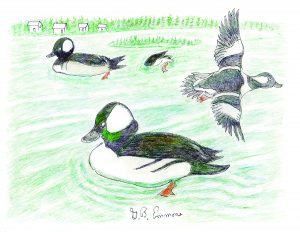This diminutive black and white diving duck – the bufflehead sea duck – spends most of the winter bobbing up and down along the icy edges of Little Bay. It is named for a large white puffy head in proportion to a black tiny body as the similar profile of a buffalo. A buoyant and elusive bird on the water, they avoid being spotted by abruptly diving to vanish out of sight and much later resurface in another location. They also are able to take vertical flight directly up from the surface unlike other diving ducks that require a long running start to become airborne. This makes them unpredictable to follow for bird watching, rapidly relocating in movement from one place to another.
The pink legs and feet used to swim and dive are visible in flight against a white body patch that wraps around the back of the head toward the body and also crosses the entire inner wing, as illustrated. If within hearing distance, they can be identified by a chattering and squeaky growling call. They easily spend half their lives underwater, made possible by prominent nasal passages on the bill to actively discharge an outflow of the buildup of a high sodium underwater salt content.
For safety, they submerge in groups and leave lookouts on the surface to warn of the approach of predators such as the local peregrine falcon that in this area is a frequent flyer patrolling the coastlines to suddenly swoop at high speeds while they are busy feeding below.
Buffleheads dine on aquatic insects, larvae, snails, small fish, and shrimp.
During courtship the males, in typical macho fashion, try to impress females with exotic behavior, swimming ahead of them while bobbing their heads perhaps to promise a positive productive potential to their mating.
They breed along forested shorelines where conifers mix with hardwoods and, like the wood duck, will nest in the hole of a tree. The bufflehead, however, is small enough to frequently move into an unoccupied northern flicker nest.
Like the wood duck, the bufflehead ducklings leave the nest within one to two days of hatching, jumping down one by one in rapid succession as far as 20 feet while furtively flapping un-feathered wings to bounce harmlessly off the ground and waddle off towards the water.
Now in the last days of winter, their migration northward is just over the horizon toward arctic-bordered shorelines above the Hudson Bay for reproduction. At the first dawn of spring, the curtain of winter season seabird entertainment from the front row seats of our living room windows will have already come down. The star performers will have quietly and unceremoniously eloped without permission or even saying good-bye.
By George B. Emmons
